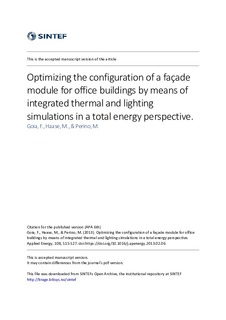| dc.contributor.author | Goia, Francesco | |
| dc.contributor.author | Haase, Matthias | |
| dc.contributor.author | Perino, Marco | |
| dc.date.accessioned | 2018-06-20T11:55:17Z | |
| dc.date.available | 2018-06-20T11:55:17Z | |
| dc.date.created | 2013-04-23T08:55:33Z | |
| dc.date.issued | 2013 | |
| dc.identifier.citation | Applied Energy. 2013, 108 515-527. | |
| dc.identifier.issn | 0306-2619 | |
| dc.identifier.uri | http://hdl.handle.net/11250/2502322 | |
| dc.description.abstract | The building enclosure plays a relevant role in the management of the energy flows in buildings and in the exploitation of solar energy at a building scale. An optimized configuration of the façade can contribute to reduce the total energy demand of the building.
Traditionally, the search for the optimal façade configuration is obtained by analyzing the heating demand and/or the cooling demand only, while the implication of the façade configuration on artificial lighting energy demand is often not addressed.
A comprehensive approach (i.e. including heating, cooling and artificial lighting energy demand) is instead necessary to reduce the total energy need of the building and the optimization of the façade configuration becomes no longer straightforward, because non-linear relationships are often disclosed.
The paper presents a methodology and the results of the search for the optimal transparent percentage in a façade module for low energy office buildings. The investigation is carried out in a temperate oceanic climate, on the four main orientations, on three versions of the office building and with different HVAC system’s efficiency. The results show that, regardless of the orientations and of the façade area of the building, the optimal configuration is achieved when the transparent percentage is between 35% and 45% of the total façade module area. The highest difference between the optimal configuration and the worst one occurs in the north-exposed façade, while the south-exposed façade is the one that shows the smallest difference between the optimal and the worst configuration. | |
| dc.language.iso | eng | |
| dc.rights | Attribution-NonCommercial-NoDerivatives 4.0 Internasjonal | |
| dc.rights.uri | http://creativecommons.org/licenses/by-nc-nd/4.0/deed.no | |
| dc.subject | Facade | |
| dc.subject | Façade | |
| dc.subject | Optimization | |
| dc.subject | WWR | |
| dc.subject | Low energy buildings | |
| dc.subject | Total energy performance | |
| dc.subject | Integrated thermal-daylighting simulation | |
| dc.title | Optimizing the configuration of a façade module for office buildings by means of integrated thermal and lighting simulations in a total energy perspective | |
| dc.type | Journal article | |
| dc.type | Peer reviewed | |
| dc.description.version | acceptedVersion | |
| dc.rights.holder | © 2013 Elsevier B.V. All rights reserved. This is the authors' accepted and refereed manuscript to the article, post-print. Released with a Creative Commons Attribution Non-Commercial No Derivatives License. The final publication is available at https://doi.org/10.1016/j.apenergy.2013.02.063 | |
| dc.subject.nsi | VDP::Teknologi: 500 | |
| dc.source.pagenumber | 515-527 | |
| dc.source.volume | 108 | |
| dc.source.journal | Applied Energy | |
| dc.identifier.doi | 10.1016/j.apenergy.2013.02.063 | |
| dc.identifier.cristin | 1025008 | |
| dc.relation.project | Norges forskningsråd: 193830 | |
| cristin.unitcode | 7401,30,20,0 | |
| cristin.unitname | Bygninger og installasjoner | |
| cristin.ispublished | true | |
| cristin.fulltext | postprint | |
| cristin.qualitycode | 1 | |

